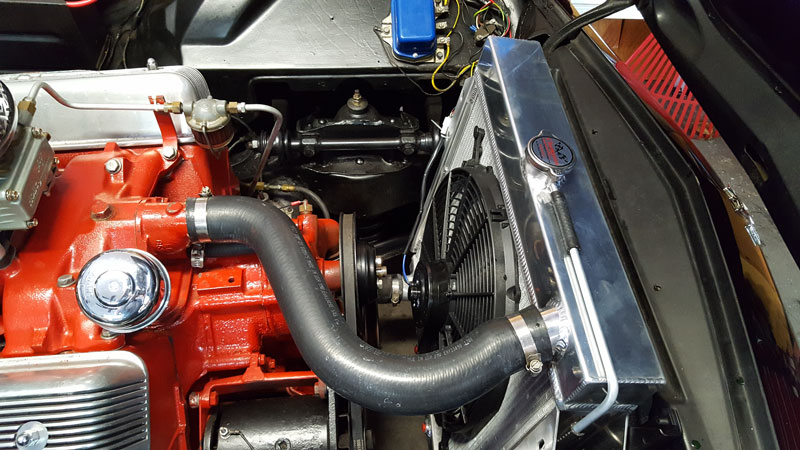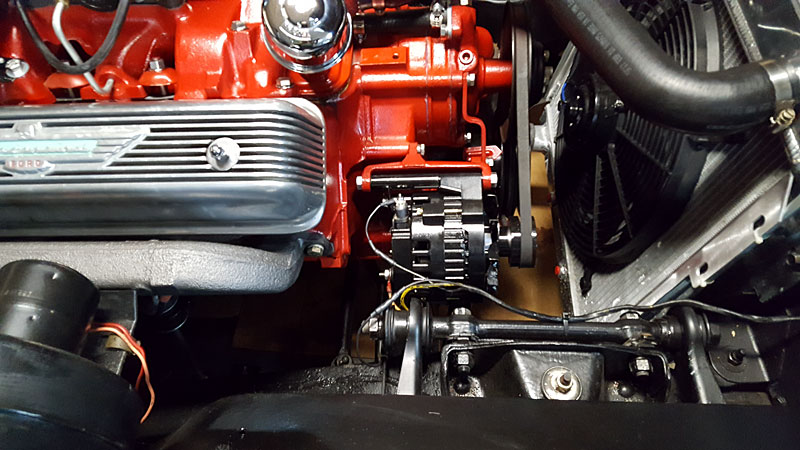|
Author
|
Message
|
|
2721955meteor
|
|
|
Group: Forum Members
Last Active: Last Year
Posts: 927,
Visits: 190.0K
|
the best way to analyze rad efficiency is temp be at least 10 degrees colder at bottom rad tank than the top.any less indicates restricted flow internal of the rad . most users claim no flow out of top rad hose. 99% that means restricted internal flow, it also causes cavitation by the watter pump.. while working for caterpillar dealer we found so called rad shops used sonic vibes to clean internal restrictions, was and is not valid. at 1 time ther was a metal rod used when tanks removed worked ok, but that was expensive
|
|
|
|
|
charliemccraney
|
|
|
Group: Moderators
Last Active: Yesterday
Posts: 6.1K,
Visits: 443.0K
|
bergmanj (4/15/2019)
Charlie, Any paint is good; oil-based is best: Again, any color. And White is best for reflecting external heat away, whereas black will also absorb external heat best while still dissipating internal heat as well as white. Gloss is best at reflecting external heat, and flat is best at absorbtion of external heat. So: Gloss white is best at radiating heat while rejecting external heat absorbtion; and, flat Black is equally as good at radiating heat; but, worst at rejecting external heat. It should be obvious that all other shades/brightnesses/finishes would fall somewhere in between. As for "differences" between radiators and electrical/electronics heatsinks, there isn't any: Heat is heat, physics is physics; and, air moving by removes just as well on either for equal exposed surface areas, turbulence, and total air flows: ALL other things being equal, painted metal will do much better (~95% range) versus "plain" metal (~65% range); and, polished metal is by far the worst (again, which is why pressure cookers are polished, for example). Everybody's very welcome to doubt any free information given here - whether it has good research behind it or not; check out the reference (General Electric SCR Manual, specifically it's 4th edition [5th edition does not have this information]), though, before doubting G. E.'s substantial research. Simply trying to be helpful; use or don't as you see fit. Regards, JLB It took a while but I have acquired a 4th edition SCR Manual. On p356, it states "Note that oil paints regardless of color improve surface emissivity to practically an ideal level." There is a chart providing the emissivity of various surface treatments. Oil paint (any color) is .92 to .96. Air drying enamel (any color), .85 to .91. Another interesting piece of info on p359 "...air flow becomes turbulent and heat transfer is thereby improved:" before the start of this quote is details about the calculation of the convection heat transfer coefficient for forced convection, not anything explaining further. It doesn't go into much detail about these but it is very interesting stuff. I never would have expected an electronics manual to have a chapter on thermal engineering, with some mechanical engineering sprinkled in.
Lawrenceville, GA
|
|
|
|
|
Florida_Phil
|
|
|
Group: Forum Members
Last Active: 2 Years Ago
Posts: 1.2K,
Visits: 285.6K
|
Back in the day, all old cars ran hot in traffic. If you drove an old car, you always carried a bottle of water in the trunk. The majority of the time this was caused by rusty leaking freeze plugs, clogged engine blocks and crappy radiators. Today, traffic is much worse than it was in the sixties. Waiting in line at a car show is asking for trouble. When you're moving at 45 miles and hour, there is plenty of air running through the radiator. Sitting at a light for 10 minutes on a 90 degree day, not so much. You will never get a 60 year old radiator to cool like a modern three row aluminum radiator no matter how many fan blades you use. Electric fans move air when you're sitting still. You won't win a Concours d'Elegance with an aluminum radiator and electric fan. You won't boil over in traffic either.

|
|
|
|
|
paul2748
|
|
|
Group: Forum Members
Last Active: Yesterday
Posts: 3.7K,
Visits: 497.8K
|
I'm not any type of "fan" on electric fans. My 54 (312) with stock radiator and four blade mechanical fan runs cool even in high temp days (It also has a wide mouth thermostat). One thing that attribute to this is that the fan is within an inch of the radiator.
While the fan is in the stock position on my 56 Bird (also 312) with a four blade fan and wide mouth thermostat I have not experienced any major problem (but it's not as good as the 54)
For my 48 (302) when I first put it together I was experiencing temperature problems (only a 4 blade fan), I put on a pusher fan besides the 4 blade. It helped a little, but still had problems. I was looking at the radiator one day and noticed that the bottom was closer to the fan than the top. I kicked out the bottom a little (not much room to do it very much), took off the electric fan and most of my overheating problems went away.. Then I put in a wide mouth thermostat and now have no problems.
54 Victoria 312; 48 Ford Conv 302, 56 Bird 312
Forever Ford
Midland Park, NJ
|
|
|
|
|
charliemccraney
|
|
|
Group: Moderators
Last Active: Yesterday
Posts: 6.1K,
Visits: 443.0K
|
An electric fan is not a necessity. The radiator does not care how air is pulled across it, be it mechanical or electrical means. Whenever I finally do make the change, I want to go with dual electric fans. The thinking there is if one fails, at least there is another to get me down the road, assuming the one is enough to keep it cool. At the very least, hopefully it will allow more time to get off the road. I think 8 amps is almost 1/3 of the current that a stock generator can provide at it's highest output, which it will be far from at idle. So a charging system upgrade will definitely be required. High performance aftermarket fans can draw quite a bit more.
Lawrenceville, GA
|
|
|
|
|
59FE258Y
|
|
|
Group: Forum Members
Last Active: 6 Years Ago
Posts: 20,
Visits: 245
|
I just talked to Auto City Classics about their $299.00 radiator, shroud, fan deal. He said the fan is 2,600 cfm and it pulls about 8 amps. There is a one year warranty. I mentioned the concern about the fans quality at only $99.00 for the fan plus shroud price. He agreed, he said that would be the one thing he would consider upgrading, because the fan is just a generic piece. I hadn't even considered the generator struggling to support the electric fan. Would the electric fan be a necessity with a shroud, aluminum radiator and perhaps a higher draw aftermarket fan? When I decide and install I'll definitely post how it works out. Thanks for all the info.
My first car (1972) was a 352 FE, 4bbl, 59 Galaxy Fairlane 500. For sixteen years I owned a 1958 Edsel Pacer (1982-1998) with the 361 4bbl, FE. Now I have this 58 292 2bbl y block. Every single one of these motors ran/ run hot in any kind of traffic or warm weather. I just wonder what people experienced overheating wise buying these late 50's Ford v8s brand new. Especially in places like Indiana in the dead of summer.
|
|
|
|
|
Florida_Phil
|
|
|
Group: Forum Members
Last Active: 2 Years Ago
Posts: 1.2K,
Visits: 285.6K
|
I don't know. The fan came as a package when I bought my radiator. It's in the car now. The radiator is a Champion. I run my fan continuously. I have a temperature fan controller, but it's so hot in Florida I find it easier to run the fan all the time. My generator was pretty weak and my engine was missing with a Pertronix unit. An alternator and the big battery made a noticeable difference. A couple of comments about this fan. It makes a little noise, but it's not noticeable inside or outside the car with the hood closed. I also removed the stock fan and shroud. My car has a 4.11 gear and the noise from the other fan was like a windmill. You can actually hear the engine now.  

|
|
|
|
|
Gene Purser
|
|
|
Group: Forum Members
Last Active: 4 Years Ago
Posts: 220,
Visits: 6.0K
|
Phil, can you tell us the manufacturer and CFM of your electric fan?
|
|
|
|
|
Florida_Phil
|
|
|
Group: Forum Members
Last Active: 2 Years Ago
Posts: 1.2K,
Visits: 285.6K
|
I would like to add something to this post as well. When new, my 1955 Bird had a 6 volt electrical system. It had been converted to 12 volts before I purchased it. One of the first modifications I made was to upgrade to a modern aluminum radiator and electric fan. This cured my overheating problems. My car does not overheat sitting in traffic on a hot Florida summer day. I quickly discovered the generator could not keep up with the extra draw from the electric fan. I upgraded by car to an alternator using a kit from Casco and installed a heavy duty 12 volt battery and tray from a 1957 TBird. No more battery problems. If you have a generator and you wish to use an electric fan, sooner or later you will need an alternator.

|
|
|
|
|
Gene Purser
|
|
|
Group: Forum Members
Last Active: 4 Years Ago
Posts: 220,
Visits: 6.0K
|
Let us know how it works out for you, feedback is good for everybody.
|
|
|
|